Samuel Love
Samuel Love was born in Dartmouth in 1882. He was the tenth child of George Love and his first wife, Elizabeth Ann Davidson.
George came originally from Lyme Regis where he began his working life as a coal merchant's labourer. On 4th June 1861 he joined the Royal Navy, beginning his service as a Boy 2nd Class on HMS Melpomene, and while serving in her, signed on for a continuous service engagement of ten years on 15th January 1863. On 21st March 1863, having made satisfactory progress and been rated Boy 1st Class, he was sent to HMS Britannia.
The Britannia, a first rate three decker launched in 1820, had been selected as the officer cadet training ship in 1859. She was first based at Portsmouth, but by the time George joined her, had been moved to Portland, a location considered more suitable for the training of "young gentlemen". However, the position at Portland was soon discovered to have other disadvantages - it was frequently exposed to bad weather, causing problems with supply, and recreation ashore for the cadets was limited. The Admiralty decided to move the ship a second time, and on 29th September 1863 Britannia left Portland for Dartmouth, under tow. On board were 108 cadets and her crew, including George. She entered Dartmouth Harbour at 0900 on the morning of 30th September 1863, to the sound of church bells and the cheers of the townspeople. The Dartmouth Chronicle of 3rd October 1863 recorded her arrival:
At an early hour the streets presented an unusually bustling appearance from the numbers who might be seen bending their way towards the Castle, from which point the noble ship might be seen with the Geyser ahead of her, under easy steam. A fresh SW breeze was blowing ... there appeared to be some little difficulty in getting the ship's head round, and having no canvas set, she would not answer her helm. At length her head was laid for the Narrows; and on she came, slowly but steadily towards the narrow gorge, which her huge bulk seemed as it if would entirely occupy. Having reached the Castle, the Geyser was cast off and the Prospero and Pilot took charge, and the Britannia allowed herself to be escorted to her moorings. The merry bells of St Saviours and St Petrox pealed forth a hearty welcome to her new home on the placid waters of the Dart.
Four five-ton anchors had been laid down just above the Floating Bridge, by which the ship was moored.
George was rated Ordinary Seaman 2nd Class on 1st January 1864 and on 7th May 1865, at St Saviours, married Elizabeth Ann Davidson, daughter of Robert Davidson and his wife Emma, born in Dartmouth in 1844. George and Elizabeth's first child, Eliza Mary, was born in 1866, and baptised at St Saviours on 17th June 1866.
George's naval career took him no further than the River Dart, for he continued to serve in HMS Britannia for many years. On 31st December 1872 his continuous service engagement was terminated, but he was immediately re-engaged on 1st January 1873 as a Domestic 3rd Class, being promoted to Domestic 2nd Class on 21st May 1878. By 1881 he was serving as a Cook.
Ashore, the family grew steadily. George Robert was born in 1867 and Tom in 1869, though that year also saw the death of Eliza Mary, aged three. At the time of the 1871 Census, Elizabeth and the two boys were recorded at Ford Cottages, Dartmouth - George (presumably) being on board the Britannia. Six children were born during the next ten years: Maud Elizabeth, in 1871; Stephen, in 1873; Martha, in 1875; Mary in 1877; Emma, in 1879, and Benjamin, in 1880. Sadly, early in 1881, the family suffered another loss when Emma died, aged one; the 1881 Census showed George and Elizabeth, with their seven surviving children, living in Clarence Street; George was also recorded in HMS Dapper, a tender to HMS Britannia, as "borne on the books of the ship but not on board on the night of 3rd April 1881".

George served in Dapper alongside John Philip Marcus, Charles William Gibbs, father of Charles Gibbs, and Charles Courtman, father of Samuel Courtman.
Arriving in 1882, Samuel was born into a large family, and he did not remain the youngest for long; another brother, Alfred, was born in 1884. But on 2nd December 1885, at Clarence Street, their mother, Elizabeth Ann died, aged only 38. George remarried in 1888 - his second wife, Maria Love, also came originally from Lyme Regis. It seems that she was one of the daughters of George's elder brother William and his wife Mary Hallett; census records suggest that William and Mary Love separated some time after 1871, and William moved to London, apparently taking his children with him. At the time of the 1881 Census, Maria Love, aged 18, was working as a domestic servant at "The Adelaide Arms", Liverpool Road, Islington. In 1886 she had a son, Harold, born (according to various records) in Dartmouth, so it seems that she came to help George with his large family soon after his wife's death.
George Love retired from the Royal Navy to a pension on 5th September 1889, but subsequent censuses indicate that he continued to work for the Navy in HMS Britannia as a Cook (and indeed after the Navy moved from the old sailing ship in the Dart into the new College buildings on the hill above). The 1891 Census recorded the family still living in Clarence Street. Sadly, Benjamin had died in 1887, aged six; but a new baby had arrived - George and Maria's son Henry was born four months before the census was taken.
By this time, the older boys had begun to leave home - George Robert went to Wales, to work in the shipbuilding industry; he married in Haverfordwest in 1890. Later he and his wife and daughter returned to Dartmouth. Tom, the second oldest, moved to West Ham, to work as a boiler maker there; and Stephen, the third oldest, moved to Bethnal Green, to work as an assistant in a grocery store in Hackney Road, where he lived "over the shop" with the manager and the other assistants. Still at home at that time were Maud, Martha and Mary - aged 19, 15 and 13, they had left school, but apparently were not yet at work, for no occupation was recorded for them. Samuel, now aged 9, was the oldest of the younger boys in the family - he, his younger brother Alfred, aged 6, and Maria's son Harold, aged 4, were all "scholars". The family was not yet complete, for after Henry, in 1891, George and Maria had another child, Olive, in 1894.
Although none of his older sons followed him into the Navy, George appears to have been successful in securing entry for Alfred to Greenwich Hospital School, from which he joined the Navy as a Boy 2nd Class on 25th January 1900. By the time of the 1901 Census, Samuel too had begun his working life. He moved to Paignton to work as a Shop Assistant, and he lived with his uncle and aunt, Samuel and Emma Wyatt. Emma was a sister of Samuel's mother, Elizabeth Ann Davidson; she had married Samuel Wyatt, a gas stoker, in 1865. By 1901, only three of their sons were still at home, all working in the building trade - Robert was a builder's mason; Arthur, a bricklayer; and Thomas, the youngest of the family, and Samuel's contemporary at 19, was a painter.
Service
However, life in a Paignton shop was evidently not enough for Samuel, who decided to join the Army. His service papers have not survived but from bits of evidence it is possible to construct some outline of his career. From his service number, we know that he joined the Devonshire Regiment some time during 1903, enlisting in Newton Abbot. By the time of the 1911 Census, he was serving with the 1st Battalion, having achieved the rank of Corporal. The 1st Devons had arrived in India from South Africa in 1902, and in 1905 went to Burma, returning to the UK in December 1908. They were based at Tidworth Army Camp on Salisbury Plain from early in 1909 until September 1911, being recorded there in the 1911 Census, and were then sent to Jersey.
But it seems that Samuel did not go to Jersey with them (or at least, not immediately). On 1st November 1911, at the parish church in the village of Figheldean, Wiltshire, he married Winifred May Sheppard. He was described in the marriage register only as "soldier", and was resident in Figheldean. The village is close to Tidworth Army Camp - so this presumably was how Samuel and Winifred met. Winifred, aged 21 at the time of her marriage, was the third daughter of Alfred Sheppard, an agricultural labourer, and his wife Martha Louisa Batchelor, who were both born in Figheldean and had married there in 1870.
Where Samuel was serving at the outbreak of war is not known. The 1st Battalion were still in Jersey, embarking for France on 21st August 1914. It would appear from the Devonshire Regiment Medal Roll that Samuel did not go to France with them, nor did he go overseas with any other Devonshire Regiment battalion during 1914 or 1915. In the absence of his service records, the only clue to his whereabouts and the nature of his service during the early years of the war is his inclusion in the "Roll of Honour" of "men of Dartmouth serving in His Majesty's Forces", published in the Dartmouth Chronicle of 17th December 1915 (the newspaper published names weekly), where he is listed as "S Love, Sergeant, 3rd [Battalion] Devon Regt". The 3rd Battalion was the training and reserve battalion for the regular battalions of the Regiment (and to begin with, the Kitchener battalions also, until the 11th Battalion was established for that purpose), and was based in Plymouth. In the casualty list announcing Samuel's death, his home town was given as Devonport.
Regrettably no further information has yet come to light about when, or why, Samuel transferred from the Devonshire Regiment to the 2nd Battalion of the Hampshire Regiment, with whom he was serving at the time of his death. It seems his brother Alfred and sister Martha, who placed an announcement of Samuel's death in the Dartmouth Chronicle (see below) were unaware of it, suggesting that the transfer had perhaps taken place not long before.
The Battle of Cambrai
The 2nd Battalion of the Hampshire Regiment was part of 29th Division, in 88th Brigade. During 1917 they had fought at Arras and as part of Fifth Army in the Third Battle of Ypres, in the Battle of Langemarck in August, and in the renewed offensive in September and October, coming out of the line after the Battle of Poelcapelle in early October.
They had arrived on 17th October at Bienvillers, southwest of Arras, for rest, recuperation, training, and the arrival of reinforcements. Although the weather was largely "fine", the Battalion War Diary observed that "The village is about two miles from the original front line and the surrounding country is full of the marks and scars of three years war".
Although they enjoyed the sports days and shooting competitions, the 29th Division's fighting days in 1917 were not over. At about this time General Haig gave his final approval for a surprise attack on Cambrai, to involve a mass tank attack, mass artillery firing at pre-selected targets of known range and position, and close coordination of tanks, artillery, infantry and aircraft. Cambrai was an important railhead, billeting and headquarters for German forces, but seems to have been selected opportunistically rather than strategically - only two German divisions held the (nearly) six-mile front to be attacked, supported by little artillery, and the ground (being chalk not mud) was suitable for tank operations. But the overall aim was ambitious, for it required both the First and Second Line systems of the strongly fortified Hindenburg Line to be overwhelmed, and the St Quentin canal to be crossed, followed by a cavalry attack to sweep round the town and take the Cambrai railway junction, thus enabling the capture of the town and forcing German evacuation of a large area.
The attacking force consisted of six infantry divisions, with the 29th in immediate support; three tank brigades; and three cavalry divisions, supported by aircraft in an assault role. Surprise and speed were paramount; but there were no substantial reserves available to exploit the breakthrough, if it was achieved. It is difficult not to conclude that the underlying rationale was not so much any strategic military objective as the political need for a quick victory, of sorts, after the losses and ultimate failure of Third Ypres.
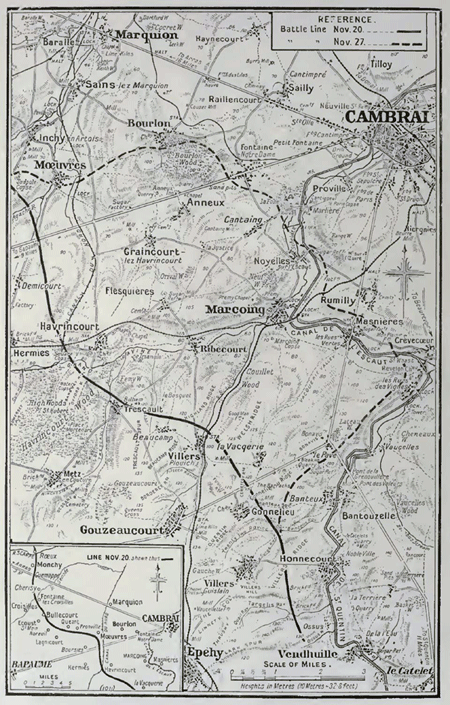
There was no long build-up on the ground, at least not for the 2nd Hampshires. The CO and two officers had their first sight of the line on 12th November, and five days later the Battalion left Bienvillers, travelling by train and their own feet to camp at Moislains, arriving at midnight. On 18th November, Battalion COs were briefed about the operation in the afternoon, and later that evening the Battalion marched to camp at Sorel. While in camp, all precautions were to be taken to keep lights to the minimum - no naked lights, all fires confined to cookers and huts, electric torches only to be flashed briefly, no continuous lights to be shown. On 19th November, they marched to the assembly area north-east of Gouzeaucourt, just behind the British front line, and then to the forming up area.
The Battalion Instructions set out the plan - the 20th Division was leading the attack on Masnieres, to the south of Cambrai, where there was a bridge crossing the St Quentin Canal (shown as the Canal de L'Escaut on the map above), and the 29th Division was to follow up close behind:
On the frontage allotted to the 88th Brigade, the capture of the Blue (1st Objective) and Brown (2nd Objective) Lines will be carried out by the 20th Division. There will be no preliminary bombardment and no wire cutting by Artillery except in one or two places prior to Zero. The attack will be made under the protection of Tanks and with the assistance of standing Artillery and smoke barrage, which will lift from objective to objective as the attack progresses.
The 29th Division will be in reserve and will be used for capture of Red Line (3rd Objective). The 88th Brigade will operate on the right and 87th in the centre.
The role of the 88th Brigade was to follow up the initial attack, and having crossed the Canal, to push forward and establish itself in the "Red Line", the 3rd Objective, to the north and east of the village. After "thorough consolidation" of the Red Line, the Cavalry would pass through to take forward the next phase of the attack, and 88th Brigade (Newfoundland and Essex Regiments) had orders to push forward after the Cavalry, leaving the Worcesters and the Hampshires to hold the Red Line as the attack progressed.
The 1st Battalion Essex Regiment led the 88th Brigade attack, with the 2nd Hampshires immediately behind with the companies in "diamond formation", illustrated in the Battalion's instructions thus:
On their left was the Newfoundland Regiment, and on their right, the 4th Worcesters.
The attack was launched at 6.20am on 20th November. 20th Division reached the bridge at Masnieres, which was already partially demolished, but when the first tank tried to cross it broke the bridge, which caused significant setbacks to the plan in this sector. Nonetheless, the 2nd Hampshires duly followed on - the CO's report of the action describes their advance:
At about 10.20am the bugle sounded the advance and the Battn moved forward in Diamond formation ... The advance was continued without any opposition except for a little sniping and machine gun fire until the Brown Line was reached [where] opposition was met from some strong points. Y Coy was sent forward to the right, and was ordered to attack the posts in this area, and mop them up; this was successfully done and about 40 prisoners were obtained.
After this the Battn was reformed and touch was obtained with the Essex Regt in front and the advance was continued, but from this point it was very slow ... I ordered the companies to move over to the right flank as advance was going too much to the left ...
This brought the Battalion to the outskirts of Masnieres, approaching up the road to the southwest of the village. Here they encountered the tank in the canal:
I then ordered ... Y Coy to attack the main bridge [over the canal at Masnieres] followed up by X and Z Coys. W Coy was ordered to move to the right and attack the houses on the main road [leading to the bridge]. I then proceeded to the main bridge and found the bridge broken in by a tank, I spoke to a Tank Officer and he told me that the bridge was impassable. I found this to be correct.
Photographs show that this was not a difficult judgement to make:
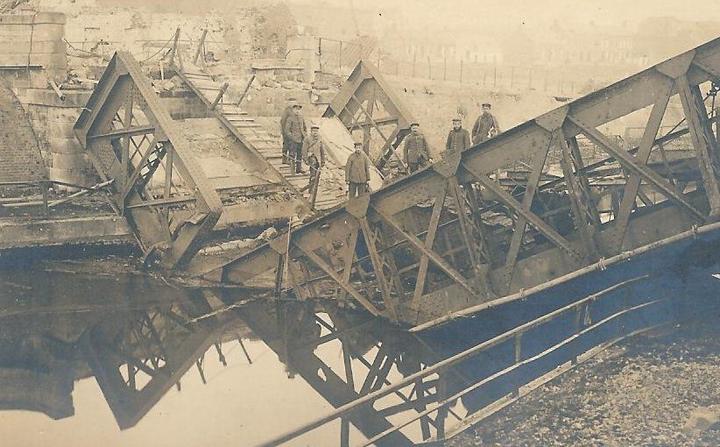
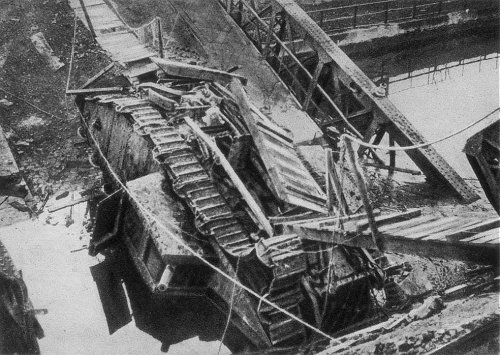
There was another crossing further along the canal at a lock, to the east, but this was slow and dangerous:
The crossing of the lock was completed by 3pm, it had to be crossed in single file and was subjected to a good deal of machine gun fire and sniping, several men were hit here. I crossed the lock with W Coy and established Battn HQ at the house by the lock ... then proceeded to the Sugar Factory [east of the village] and found W and Z Coys on the left of the Worcesters, X Coy were still mopping up in the village.

Y Company, meanwhile, was still holding the main bridge. W and Z companies then consolidated a line running north from the canal, across the road to the east of the village (map references G21 c 9.0 - G27 b 0.8). At this stage the village was still held "fairly strongly". Y Company then crossed the lock, and a platoon was detailed to hold a strong post on the canal.
At about 10pm the 2nd Hampshires CO was ordered to take command of all troops east of the canal, which "then comprised 4 Coys Hampshires, 2 Coys Worcesters, 1 Coy Essex". He was to "mop up" the village as far as the Cambrai road and then push out patrols to the Masnieres-Beaurevoir Second Line System, which ran north of the village, and report how strongly it was held.
On the basis of those reports, an advance was ordered shortly after dawn the following morning towards the Masnieres-Beaurevoir line but met with "a good deal of opposition" from machine gun fire from the trenches south of the village of Rumilly. During the night of 21st/22nd, the Battalion consolidated the position it had reached. An attempt on the morning of 22nd to push up the Rumilly road and "bomb down the trenches" failed, due to enfilade fire from Rumilly itself.
The Battalion War Diary further reported that, during the mopping up operations:
... several men were caught in the houses, who wore German uniforms with civilian greatcoats, and they said that they were French, after they were removed there was no further sniping from the houses. These men were sent to the rear under escort."
Across the front as a whole, a considerable advance had been achieved in many areas - the First Line System of the Hindenburg Line had been overrun to a depth of around three to four miles, at relatively low cost in terms of casualties (around 4000). But, the cavalry were unable to deploy forward to any substantial effect, and on the left of the front, a high point, the Bourlon Ridge, remained in German control. The tanks had overall proved very effective, but losses were high - 179 had been destroyed, disabled, or had broken down.
During the next phase of the Battle, from 23rd-27th November, hard fighting (with heavy losses) secured Bourlon Wood. 2nd Hampshires were not involved, being moved to hold the village of Marcoing, taken on the opening day by 6th Division. The War Diary describes the next few days:
24th: spent the day in cleaning up and all battle stores were made up. Divisional Commander interviewed all COs at 11am and discussed previous operations and congratulated the Battn on their work. Village shelled during the day.
25th: Marcoing. Y Coy was sent forward as a bridgehead defence for main bridge over canal at Marcoing. The village was shelled during the day and night. 2 killed, 1 wounded.
26th: Marcoing: relieved 1/KOSB in right sub-sector North of Cambrai Road at 7.30pm ... quiet night but hostile artillery active on and around Reserve Coy and canal
27th: Barrage opened at 6.30am, hostile artillery active in response on front and support lines. Conference of Cos at Brigade HQ to discuss method of holding the line. 2 killed, 11 wounded.
28th: Relieved by Royal Inniskilling Fusiliers; returned to Marcoing. Village shelled overnight.
29th: Marcoing: Day spent cleaning up, Battalion confined to billets due to heavy enemy shelling. Another COs conference at Brigade HQ. During the night 29th/30th the Battn was billetted in cellars at Marcoing which was subjected to heavy shell fire during the night of which a large proportion were gas shells.
As the War Diary suggests, a key problem was how to hold the new salient created by the attack, approximately nine miles wide and four miles deep, and acutely vulnerable to attacks from both sides. During the attack on Bourlon Wood, and despite the serious situation created by the initial British success, the German Army had nonetheless been able to bring up up substantial reinforcements and plan a major counter-attack. Notwithstanding the conferring about how best to hold the line, the German attack appears to have been a surprise in its turn. As it began on the morning of 30th November, there was panic and confusion. The 2nd Hampshires War Diary, whilst making the best report possible, shows plans changing rapidly as the attack developed:
At about 10.30am a message was received from Brigade that the Battn was to move out at once and assemble ... south of Masnieres-Marcoing Road [west of Masnieres] in order to support right of 86th Brigade ... I myself moved off at once with my Adjutant ... On my way through Marcoing I met the Brigadier who told me that the enemy were advancing on Marcoing and that the Battn was to seize the high ground south of it.
This was a difficult operation now as the Coys were on their way to their assembly positions and Marcoing was being heavily shelled, with the result that the Coys were picking their best way through it. I proceeded as quickly as possible to the road junction [south of the village] and stopped X, Y and W Companies, and ordered them to attack towards the high ground south of Marcoing, as the enemy were now quite close to the village. Z Coy had proceeded to the SE and attacked through Marcoing Copse. The other 3 Coys deployed and attacked and drove the enemy back and occupied the trenches [south of the village - the "Marcoing Line"]. The enemy were now holding the high ground [just beyond] so orders were given to Coys to attack this position, which they did successfully in conjunction with troops of nearly every regiment in the Brigade.
In this attack about 20 Officers and 50 prisoners were taken and the enemy was driven back, but heavy MG fire was encountered. We then occupied a line [running approximately SW-NE south of the village]. At about 1.30pm orders were received that the line was to be held by the Worcesters on the right, Essex centre, Newfoundlands on left, Hampshires in reserve about the Sunken Road [south of Marcoing]. The Companies of the Battn were by now mixed up with all the other troops, so it was some time before they could be collected together in the Sunken Road ... During the night consolidation was carried out with very little interruption except for occasional bursts of Machine Gun fire. Z Coy who had proceeded to the SE attacked just on the south side of Marcoing Copse and established themselves after a lot of fighting.
It appears that the next day, the Battalion was able to hold the line they had established, though both Marcoing and Masnieres were heavily shelled. They were apparently able to take a roll-call at that point in the action, as the War Diary states, at the end of the report of that day, that total casualties during 30th November were three officers and 120 other ranks (there is no breakdown given of those killed, wounded or missing). Evidently Samuel was one of those reported killed.
Fighting continued over the next three days until General Haig ordered withdrawal across the front to a more defensible line on 3rd December. After blowing up the bridges over the canal, the withdrawal was achieved "unmolested by the enemy." But both Marcoing and Masnieres were abandoned.
Death
News of Samuel's death reached Dartmouth before his name appeared in the daily casualty lists. The Dartmouth Chronicle of 4th January 2018 carried the following announcement, placed apparently by his brother Alfred and sister and brother in law Martha and John Phillips:
Deaths
Love - November 30th, killed in action in France, Qr Mstr Sgt Samuel Love - Devon Regt, aged 35 years. Beloved brother of Alf Love and M & J Phillips. Deeply mourned by all.
It will be seen that the family was unaware that, by that time, Samuel was serving in the Hampshire Regiment.
Commemoration

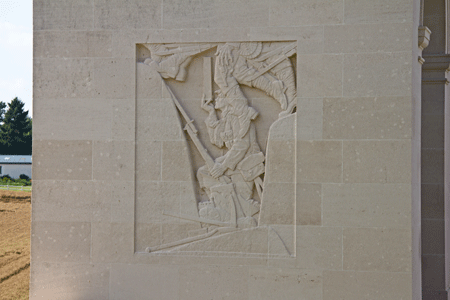
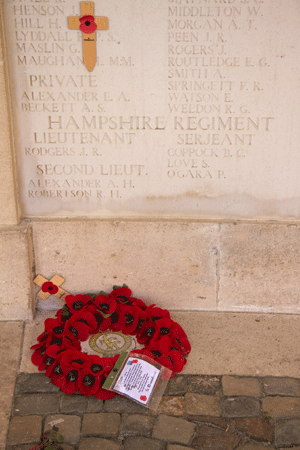
In Dartmouth, he is commemorated on the Town War Memorial and the St Saviours Memorial Board.
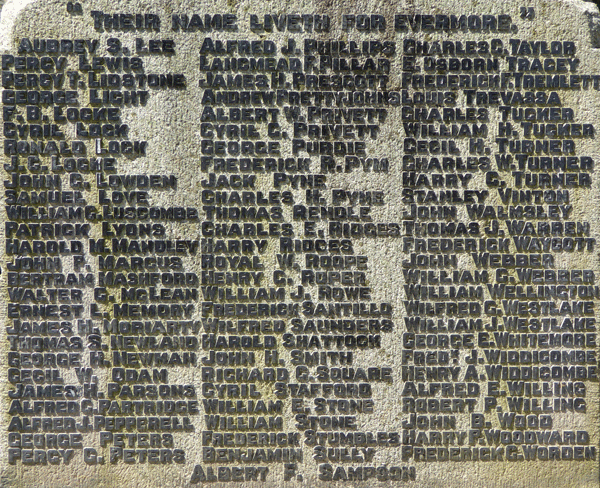
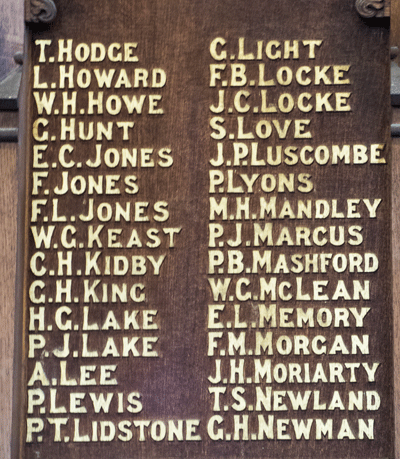
Samuel's brother Alfred joined HMS Agincourt as an Able Seaman at the start of the war and served in her throughout, including at the Battle of Jutland. He survived the war and left the Royal Navy in October 1922.
Harold Love also joined the Royal Navy, serving as an Engine Room Artificer in the destroyer HMS Lively throughout the greater part of the war. He too survived the war, but was invalided out of the Navy in January 1922 with TB.
Sources
Naval Service Records available at the National Archives, fee payable for download, references:
George Love: Naval Service Record ADM 139/577/17666 and ADM 188/35/58260
Alfred Love: ADM 188/362/207725
Harold Love: ADM 188/1018/200
The Bloody Eleventh: History of the Devonshire Regiment, volume II 1815-1914, by W J P Aggett, publ Devonshire and Dorset Regiment, Exeter, 1995
War Diary of the 2nd Battalion Hampshire Regiment, March 1916-February 1919, available at the National Archives, fee payable for download, reference WO 95/2308/3
The Cambrai operations, 1917 (Battle of Cambrai) from The Long Long Trail
The Great War, by Peter Hart, publ 2014, Profile Books
Information Held on Database
| Surname: | Love |
| Forenames: | Samuel |
| Rank: | Sergeant |
| Service Number: | 41947 |
| Military Unit: | 2nd Bn Hampshire Regiment |
| Date of Death: | 30 Nov 1917 |
| Age at Death: | 35 |
| Cause of Death: | Killed in action |
| Action Resulting in Death: | Battle of Cambrai |
| Place of Death: | Near Cambrai, France |
| Place of Burial: | Commemorated Cambrai Memorial, France |
| Born or Lived in Dartmouth? | Yes |
| On Dartmouth War Memorial? | Yes |
| On St Saviour's Memorials? | Yes |
| On St Petrox Memorials? | No |
| On Flavel Church Memorials? | No |
| In Longcross Cemetery? | No |
| In St Clement's Churchyard? | No |
| On a Private Memorial? | No |
| On Another Memorial? | No |















